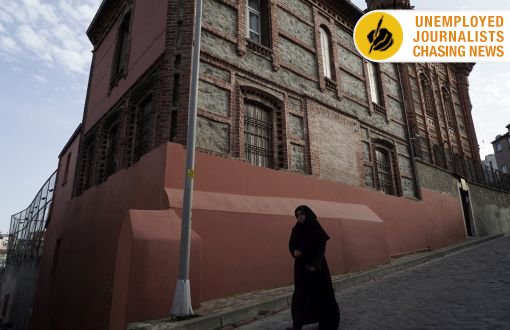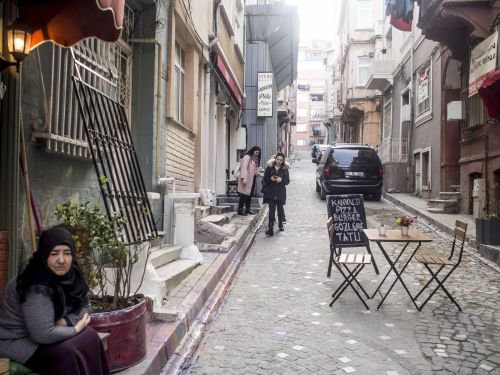Click to read the article in Turkish and Kurdish
The ancient Jewish neighborhood Balat, which lies along the Byzantine sea walls by Haliç (the Golden Horn), is now one of the last fortresses that Romans took shelter in. The gentrification process that has been continuing for 15 years is in its third stage.
The first stage, which started in the beginning of the 2000s, was a rehabilitation project launched in cooperation with Fatih Municipality and the European Union with the goals of preservation and improvement.
In the second stage, this project was replaced with the Fener-Balat Renewal Project. So, the restoration work led by Fatih Municipality and the European Union was replaced with new projects run in partnership with the public-private sector. The area was declared a renewal area in 2006 through the “Law on Preservation by Renovation and Utilization by Revitalizing Deteriorated Immovable Historical and Cultural Properties”. GAP Construction, which was connected to Çalık Holding won the tender of the preliminary design in 2007. The project was halted thanks to objections raised from civil society. Today, in its last stage, a transformation has taken place through the individual capital entering the neighborhood.
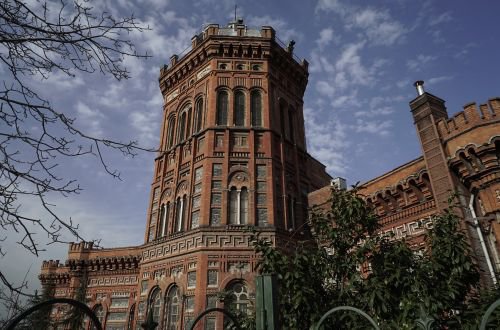
About Article No. 5,366According to Article 4(f) in the "Definitions" section of the Regulations for Application published on the Official Gazette issue No. 26023 entering into force on 14/12/2005 which was prepared in accordance with the Law No. 5366 on “Preservation by Renovation and Utilization by Revitalizing of Deteriorated Immovable Historical and Cultural Properties” and approved by the Cabinet Decree No. 2005/9668 of 17/11/2005, "renovation zones" are characterized as "areas registered and announced as conservation and protection areas as well as areas within these whose borders are determined and agreed upon by the Cabinet upon request of the administrative body.” |
Since the people living in Balat for generations haven’t prospered at the speed requested by the neoliberal policies, they cannot adapt to the new face of the city and district, which made these people poorer and has driven them to earn money through illegal means. As history’s rusty marks are zoned for construction and painted over, the Balat residents cannot see their own future amidst the new colors of the district.
It is now a very ordinary thing to see a boutique hotel on every street. In this area that sustains its traditional neighborhood culture, the number of new generation coffee shops that sell a cup of coffee for 10 TL (2.5 Euros) is increasing day by day. Through social and economic dynamics, the gentrification project is being carried out by through natural means in Fener and Balat, which are the new favorites of domestic and foreign tourists; urban transformation could not achieve this. The residents who become poorer with each passing day are being silently kicked out of the district.
Glass artist Yasemin Aslan Bakiri carries on with her work in Camhane, an old Rum house, of which İstanbul Mayor Kadir Toptaş joined the in restoration work in person 15 years ago. Her door is open to everybody, especially to Balat residents. However, she says that Balat residents are not really interested in her works.
“The new coffee shops are temporary”
Camhane is one of the successful examples of Balat’s restoration works. Every detail in the shop was renewed in accordance with the original. Bakiri decorates her works with Ottoman motifs to maintain the spirit of the shop.
Bakiri is very disturbed by the increasing number of new coffee shops. Saying that “Everyone and their brother are opening coffee shops like in Tünel or Galata, but they are all temporary”, Bakiri complains about dullness of the new venues. “Antique shops are everywhere, but those ‘antique shops’ have turned into flea markets. Those kind of things have bad impact on the area. I feel sad. Those things were done in Galata too but it deforms the fabric of the space and its naturalness”.
Bakiri claims that “insensible people” have had a share in Balat turning into a center of profit through gentrification. Bakiri believes that the people who handed their properties over to investors didn’t look at their living environment with passion due to their economy-oriented mindset. “It is not right to gain something by destroying historical places”, Bakiri says and adds that “It is important to sustain and know the value of existing things rather than just adding something to it. The neighborhood culture needs to be protected”.
The district shaken by waves of migration
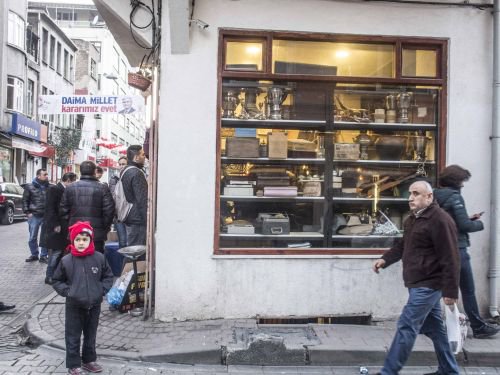
What is urgent expropriation?Urgent Expropriation is regulated through the Law on Expropriation No. 2,942.
|
One only needs to take a glance at the history of Balat in order to understand the gentrification process Balat has been experiencing recently. The district became an area in which minorities, especially Jewish people, lived in the first years of the Republic of Turkey. The non-Muslim minorities abandoned the district in the wake of the events of September 6-7, 1955, and Turkish invasion of Cyprus. Due to its closeness to working areas downtown, the area was one of the first stops of those who migrated from rural areas to the big city until 10 years ago. It has become one of the favorite areas of young entrepreneurs and artists who seek new addresses for themselves…
The Hebrews and Rums who were residing in the Fener-Balat area before the Ottoman times sustained their existence during the Ottoman period as well. A decrease in commercial life on the shores of Haliç after the 19th century as well as fires caused Balat to fall from grace. With the French city planner Henry Prost’s plan to bring industry to the area in the 1930s, Balat changed its face after the state established factories and manufacturing shops there.
Migration started from the Eastern and Southeastern Anatolia to the districts of Fener and Balat in 1985, which is about the same time that work was done to clean the Haliç inlet. For the people who came through forced migration, not only did they not have a village or hometown to return to but they also didn’t have a job waiting for them. The reason people choose this place was indeed its closeness to working areas downtown and its cheap rent. The last migration wave that occurred in that period formed the district’s present social and economic structure.
The EU Project left unfinished
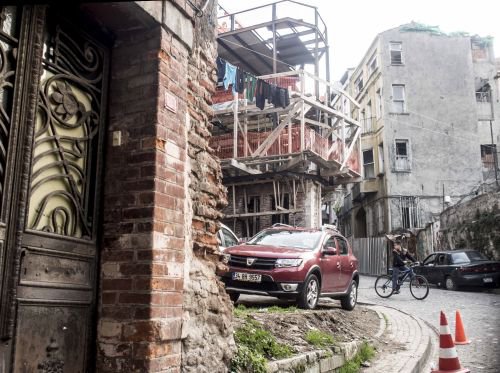
Balat’s surroundings and sea were cleaned and the de-industrialization process was completed. After the historical peninsula was added to the UNESCO World Cultural Heritage List in 1985, the value of the area multiplied. The rehabilitation of Balat and Ayvansaray was discussed in the HABITAT Conference that was organized in İstanbul in 1996. Nevertheless, the project could only be put into practice in 2003.
The European Union granted 7 million Euros to Turkey for rehabilitation and restoration work in the area. During the restoration, not only were the landowners or renters not evicted, but also they weren’t asked to pay anything. Furthermore, with an agreement signed with the landowners, the EU banned the landowners to from selling their buildings or evicting their renters for five years after the restoration of the building was completed. As restoration costs exceeded the expectations, Fatih Municipality fully restored 35 buildings, and carried out simple maintenance in 121 buildings.
In 2006, the Fener-Balat-Ayvansaray Renewal Project was declared on the grounds of the “Law on Preservation by Renovation and Utilization by Revitalizing Deteriorated Immovable Historical and Cultural Properties”. In 2007, GAP İnşaat (GAP Construction) incorporated within Çalık Holding, which we know from the Tarlabaşı Renewal Project, won the tender of the preliminary project. The agreement with the EU was thus cancelled without asking the local community. Furthermore, the 121 buildings in which basic maintenance was carried out were added to the list of 3,000 buildings to be demolished.
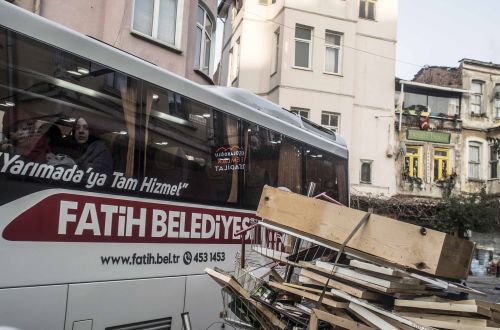
The details and goals of the projects were described on GAP İnşaat’s official website as follows:
The current renewal area consists of the area located where the upper walls start (Ayvansaray and Mürselpaşa streets) to Haliç, which comprises 59 city blocks, 909 parcels and the neighboring areas. This is a 79,345 meter square area in gross. The project’s primary goal is to ensure the area’s physical structure be renewed and its social structural capacity be increased. At the same time, the project aims to improve the present usage and enrich the lives on the coastal regions through the new usage. It is also intended that the residential character in the Fener-Balat area be supported and enriched through touristic functions. Despite its central location in the city, the region has been left outside due to its introverted character; increasing the potential of the region is among the goals of the project. The projects involves various architectural approaches such as restoration, restitution, and creating new projects, and projects that supports combined usage.
Annulment decisions, urgent expropriation and finally, the victory
The Fener-Balat-Ayvansaray Renewal Area Preliminary Project was approved in Fatih Municipality Assembly in December 2009. Following this decision, the local community gathering under the roof of the Association of Preserving Fener Balat Cultural Heritage (FEBAYDER) challenged the decision and the legal process started.
The people’s efforts were fruitful and the court ordered the cancellation of the project in June 2012. Despite the annulment, the Council of Ministers ordered urgent expropriation for Fener-Balat-Ayvansaray. The FEBAYDER didn’t give up on the case and it was ruled that the execution of the project be suspended in May 2013, and in September, the Council of State annulled the expropriation order. The case concluded with the İstanbul 1st Administrative Court cancelling the Fener-Balat-Ayvansaray conservation development plan that included the Fener-Balat-Ayvansaray renewal project. The Balat residents took a deep breath in the face of the destruction threat, however, what the urban transformation couldn’t achieve would be achieved through social transformation.
Tourism based on consumption and shopping
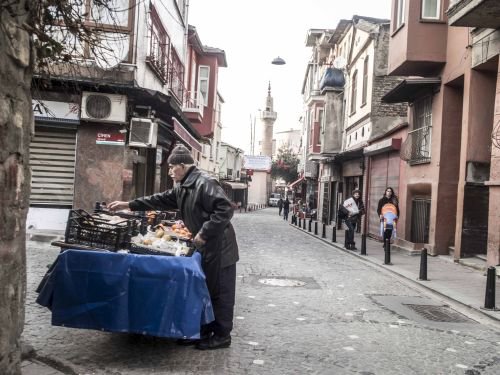
FEBAYDER spokesperson Asst. Prof. Dr. Çiğdem Şahin says that they became the first victims of the urban transformation projects and adds, “Unfortunately, when this started to happen here, the proceedings weren’t very clear and it was difficult to find ways to struggle against this. Now, everyone knows everything”.
Çiğdem Şahin says that eye of the investors and the state is always on region since there is no place left for profit through gentrification, or areas that have not been subject to urban transformation in İstanbul. Şahin also underlines that the historical value of places is disregarded in urban transformation or social transformation, and that tourism is established based on the scenery rather than the realities. “They speak of a tourism based on consumption and shopping. They don’t mention the value of region, it is a decor-tourism. People will make money on hotels, restaurants, night clubs, and coffee shops. People won’t make money from touristic or cultural values”, Şahin says.
Prof. Dr. Seçkin Dindar, who purchased in his own words a “garbage dump” near the Anemaş Dungeons in Ayvansaray and turned it into a hotel and cafe, says that what adds value to a place is history, and history cannot be purchased. He adds that a restoration in accordance with the original cannot be done with a money-oriented approach but one has to do this type of work voluntarily.
This is a cultural transformation

Seçkin Dindar, who bought four historical buildings and restored them from the scratch, has a hotel, a dorm and a cafe in Ayvansaray. Dindar says that he is the first investor who came to Ayvansaray, and no second investor has taken this risk yet, but it won’t last long. “Fener-Balat-Ayvansaray is the only place whose historic fabric is unharmed since it didn’t go through urban transformation. You can also mention Sultanahmet but many big hotels were built there. The other place is the Galata area but there is no space left there. Now the Fener-Balat-Ayvansaray region has the highest potential for profit through gentrification”.
Having served as presidential advisor at İstanbul University 11 years ago, International Academic Council head and Social Projects president, Prof. Dindar now works as a social media consultant under the Media Association for 60 universities. He holds “conversations on history and culture” sessions for social clubs and all of his students on weekends. “I’ve arranged tours for hundreds of people and I’ve created awareness by encouraging them. In all my speeches, I said that all intellectuals and artists have to come here”. Dindar claims that the region is in a cultural development stage: “This region has to turn into a place where intellectuals and artists live. It already has started. For instance, I know an artist who brings wood to life. I know an artist coming here to open an art exhibition on March 8. I opened a photography exhibition here. The authors come and sign their books”.
He states that many doctors and artists have moved to Balat, Ayvansaray and Fener, thanks to him. “I think this is a huge change and a really big social project”, Dindar notes and highlights that value of the region will be protected this way.
It will transform by itself even if not through urban transformation

Since industrial age that started in the 1930s made Balat a profitable location for settlement, the de-industrialization process that started in the 1980s drove the local community to poverty. Even though the re-structuring projects that came to agenda in the 1990s became a hope for prosperity for the local community, the improvement projects that came to agenda in the 2000s carried the concept of poverty, which is already well known by the residents, to another level: The fear of being dispossessed. Each project that promised to benefit the people has made the people even poorer.
The urban transformation system, which succeeded in Sulukule and Tokludede by displacing people, failed in the Fener-Balat-Ayvansaray Renewal Project. And now, the gentrification plans that couldn’t be achieved through demolition have been attempted through the market mechanism, which is under the control of the investors. What urban transformation failed to do is being done by capital. Gentrification is happening “some way or another”.
Asst. Prof. Dr. Çiğdem Şahin, who has been living in Balat for many years and has been taking an active role in urban movements, says that the Fener and Balat regions have been attempted to be opened to investors through a process like those for Cihangir, Tophane, and Ortaköy. Şahin states that the prices are increased via speculation and it is planned that the landowners will sell their houses, which they haven’t sold it to the municipality due to low prices, to the investors with high prices. With the new population offering high prices coming into the area, the poor will not be able to resist these prices anymore and leave the area. “We as the local community prevented the urban transformation plan, but now they are trying plan
“Gentrification is inevitable”
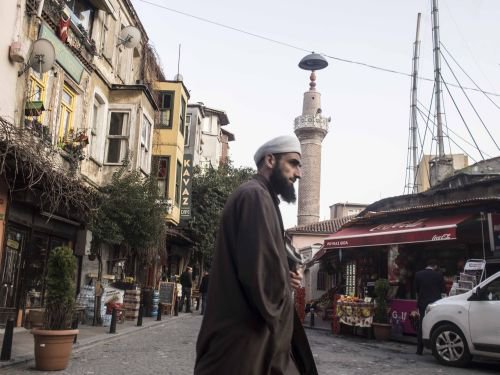
Journalist-writer Ersin Kalkan, who restored historical Agora Meyhanesi (Agora Tavern) in Balat and opened it in 2014, is one of the figures who were born in Balat and makes an effort for the neighborhood. Kalkan says that the urban transformation threat has been avoided but the social transformation continues. “This is inevitable. It is the same with Barcelona or New York. This place can no longer be a Tarlabaşı”. Kalkan adds that after the case concluded, people have started restoration and opened cafes, and now there won’t be return from this point.
When we head away from the new face of Balat to the side streets, you encounter lives that wouldn’t really interest investors. The children aged 14-15 are married off with their families’ consent and give birth to children with “clean” files. Every newborn child means a clean crime record and a new income opportunity for the families. The jobs these children are forced to do are drug trafficking and robbery.
Most of the Romani people, one of the last remaining minorities in the area, are musicians or tourism professionals. Following the rapid collapse of tourism in recent years, their income has decreased in half. As their income decreases, rent increases, which leads them to desperation and to resort to illegal routes. Using and selling drugs is one of the important problems in Balat. “There are three children at home, they are hungry, who will feed them?” a musician says. They speak about the uncertainty of their future, increasing rent and music as they drink beer or tea on their way to home from work. They are aware that the new face of the district excludes them; they cannot adapt. “Life is too hard to bear sober”, a Romani musician who spoke on the condition of anonymity says, and adds that they are held accountable for every robbery in the district. He or she stresses that they don’t work at insured jobs, and the employers also don’t want to employ them at such jobs.
The area is terrorized through illegal interventions
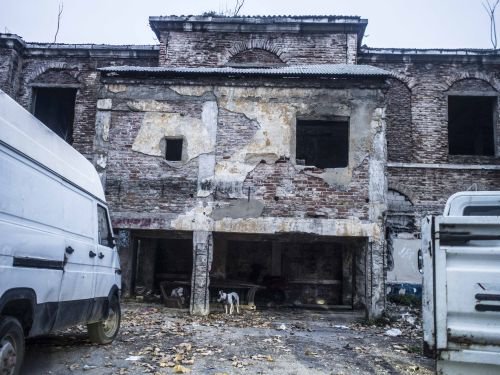
Asst. Prof. Dr. Şahin says that reason for the illegal problems in the area is the last stage of the persuasion methods during the urban transformation process. When the one-on-one persuasion efforts fail, a trivialization policy carried out to discredit the area is implemented in Fener and Balat. “They put paint thinner addicts and drug mafia in the area. After a while, the people say ‘If I stay here, my child will fall into the hands of the mafia or get used to drugs. Damn it, I am leaving’.
“Our door is open to everybody as long as they don’t disturb us”
From Halit Vitali, who had to do illegitimate work after working in the textile sector and at a coffee house. “It is not safe anymore, but we will stay here to the end”, Vitali says. “They come here everyday as they are possessed with the area, checking the stones of the buildings, taking notes, and they want to make contracts of 5 or 10 years. My flat is upstairs and I have nowhere else to live or breathe. I don’t know any other life but just this inn and the coffee house. We sit with men who want to relieve their tiredness with a couple of beers at the end of the day. Our door is open to everybody as long as they don’t disturb us”. (EE-ŞÖ/HU/HK)
***
UNEMPLOYED JOURNALISTS CHASING NEWS
1- Even Though They Speak Through Their New “Occupations,” They Are Journalists
2- Journalism is Banned under theState of Emergency
3- Germany: New Generation Diaspora/Kopuntu
4- Germany: Immigration of the Suffocated
5- The Organization that Made "The Arab Girl Looks from the Window"
6- How They Work/Cannot Work, Breaking Down the Stereotypes
7- They Marry White People to Avoid Discrimination
8- Private Rehabilitation Centers and Problems: The Example of Bingöl
9- Two Directors Discuss the “Educational Support for People with Disabilities” Practices
10- Students and Parents from Bingöl Tell of Their Experiences
11- 'Solution is Inclusion System in Education for People with Disabilities'
12- The Neighborhood of "Giaour" Doesn't Exist Anymore
13- Mıgırdıç Margosyan Couldn't Recognize His Street Amidst Ruins
14- The Ones Who Choose Life, Love, and to Struggle, Just to Spite Hatred
15- Şahika: You Don’t Become A Trans Woman Later
16- Emirhan: It's Necessary to Have An Organized Struggle and to Record Our Experiences
17- Sarmaşık Association Was Closed; Where Does This Leave the Victims?
18 -An Alternative Bank: The Sarmaşık Food Bank
19- Sarmaşık Association is Closed; “They Are Neither Hungry nor Full”
20- Balat: A Modern İstanbul Project in a Historical Setting
21- Art Gripped by The Trustees
* The "Unemployed Journalists Chasing News" project is being realized with the financial support of Matra-Human Rights Program of Consulate General of the Kingdom of the Netherlands.




